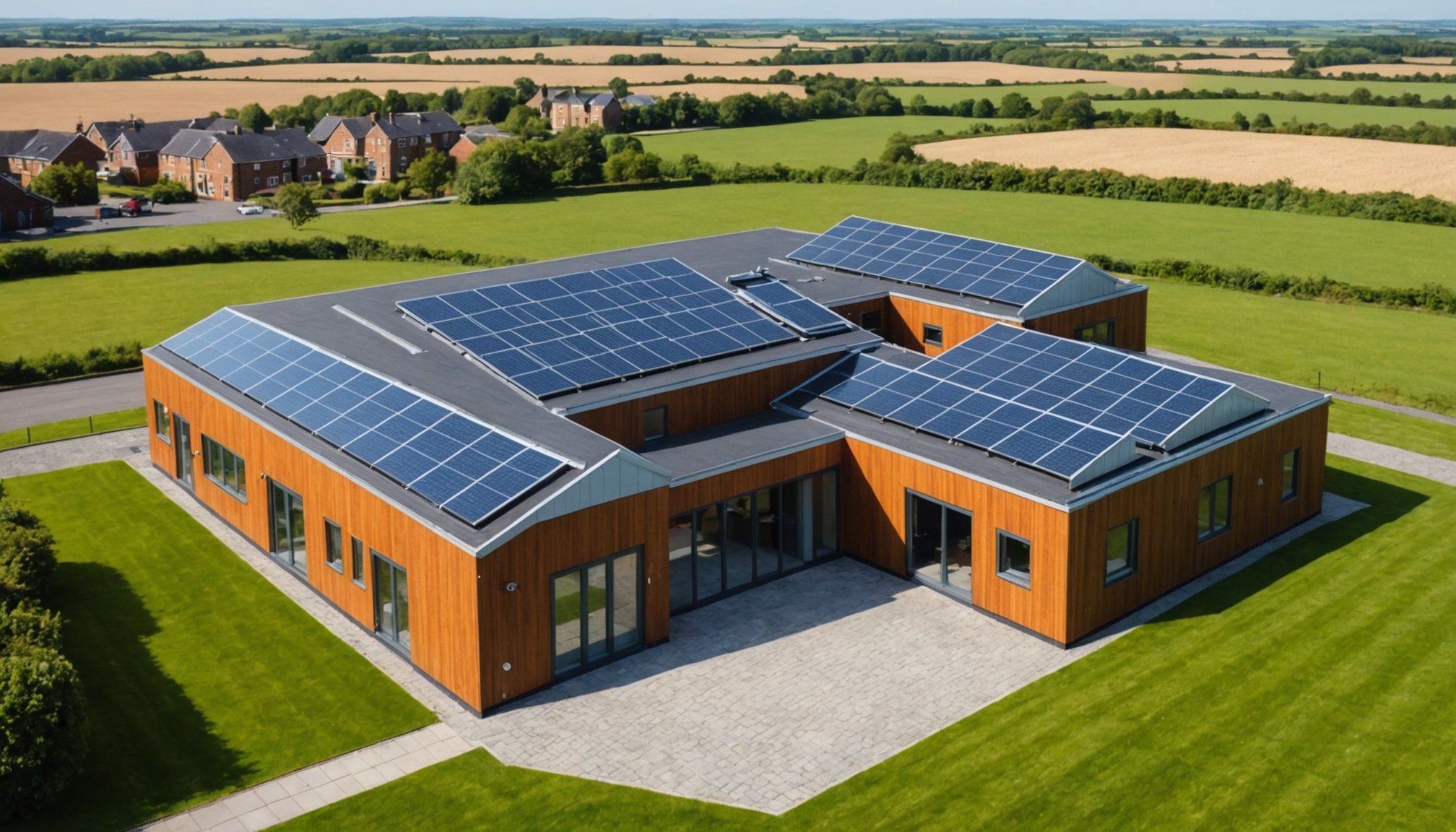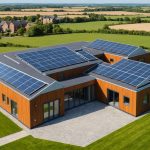Definition and Overview of Zero-Energy Buildings
Zero-Energy Buildings (ZEBs) are structures designed to produce as much energy as they consume over a year, resulting in a net-zero energy balance. These buildings achieve remarkable energy efficiency through integrating renewable energy sources like solar panels and advanced insulation materials. The sustainability of ZEBs aligns with modern architectural goals, reducing reliance on fossil fuels and promoting environmental conservation.
The core principles of ZEBs include optimizing building design for passive energy use, implementing energy-efficient appliances, and utilizing cutting-edge technology to manage energy consumption effectively. These features emphasize sustainability and illustrate the increasing importance of eco-friendly construction methods.
This might interest you : Navigating the distinctive hurdles of managing heritage properties in stratford-upon-avon
Historically, the concept of zero-energy living dates back to the 1970s when architects and engineers began exploring ways to minimize buildings’ energy consumption. Initially seen as niche solutions, the interest in Zero-Energy Buildings gained momentum due to growing environmental concerns and advancements in sustainable technology. The evolution of ZEBs reflects a shift towards sustainable architecture, integrating traditional design with modern innovation.
Incorporating Zero-Energy Buildings into national energy policies has sparked considerable interest in the environmental, economic, and social benefits they offer. By fostering sustainability, ZEBs are paving the way toward a greener, more energy-efficient future in architecture.
This might interest you : Navigating tenant evictions in a post-covid uk: a comprehensive guide for landlords amid changing legal dynamics
Benefits of Zero-Energy Buildings in Northern UK
Zero-Energy Buildings (ZEBs) offer a range of benefits in the Northern UK, with one primary advantage being significant energy savings. By generating as much energy as they consume, ZEBs minimize reliance on traditional power sources and reduce energy bills. This leads to decreased operational expenses, offering financial relief to homeowners and businesses.
In addition to economic perks, these buildings contribute considerably to sustainability efforts by reducing carbon footprints. As they rely heavily on renewable energy sources, ZEBs help lower greenhouse gas emissions, thus supporting nationwide carbon neutrality goals. This aligns with broader environmental agendas, highlighting the importance of sustainable practices in architecture.
Occupant comfort and well-being are further benefits attributed to ZEBs. With improved insulation and energy management systems, these buildings maintain optimal indoor environments. Enhanced air quality and thermal comfort levels promote healthier living and working spaces.
Overall, ZEBs play a crucial role in integrating sustainability into modern construction, reflecting continued progress towards environmentally responsible building solutions. By exploring these advantages, stakeholders are encouraged to adopt ZEBs, reinforcing a commitment to a greener, more sustainable future.
Challenges Faced by Zero-Energy Buildings in Northern UK
Zero-Energy Buildings (ZEBs) in the Northern UK encounter several hurdles, especially due to specific climatic challenges that affect their performance. The region’s cooler and cloudier weather can limit solar energy generation, a primary source for these buildings. This necessitates advanced insulation and innovative design to maintain energy efficiency.
Furthermore, building regulations and codes present challenges. Existing frameworks may not fully accommodate the innovative techniques required for ZEBs, leading to bureaucratic delays and revisions. Navigating these regulations is crucial for successful implementation, needing both expertise and persistent efforts from stakeholders.
Investors and developers face financial uncertainties as well. Initial costs for ZEB construction can be significant, making it harder to secure funding. The investment landscape is still maturing, with limited tailored incentives. Stakeholders need to balance upfront expenditures with anticipated benefits—this represents a major challenge.
Resolving these issues requires collaboration and strategic planning. Engaging policymakers to improve regulatory environments and introducing financial incentives could ease the adaptation process. Stakeholders’ commitment to overcoming these challenges can drive the broader acceptance of ZEBs, paving the way for more sustainable urban development.
Case Studies of Successful Zero-Energy Buildings
Exploring case studies of Zero-Energy Buildings (ZEBs) provides valuable insights into their successful implementation. Notable projects in the Northern UK exemplify best practices and innovative approaches that have led to positive outcomes. These projects demonstrate the combination of advanced technology and sustainable practices, setting benchmarks for future developments.
Notable Projects in Northern UK
The Kingston Heights residential complex in London is an exemplar, successfully employing water-source heat pumps to achieve zero-energy status. This innovative approach leverages the Thames River’s thermal energy, exemplifying resourcefulness in energy efficiency. The scheme proves best practices in ZEB implementation, illustrating how integrating local resources benefits energy performance.
Lessons Learned from Implementation
Key lessons learned highlight the importance of early stakeholder engagement and thorough planning. Successful ZEB projects emphasized collaboration between architects, engineers, and policymakers. Clear communication and shared goals ensured streamlined implementation processes, overcoming potential barriers effectively.
Best Practices for Future Developments
Future developments can draw from existing case studies by prioritizing site-specific solutions and embracing emerging technologies. Adapting building designs to local climatic conditions and utilizing indigenous resources are strategies that enhance sustainability. Commitment to these best practices will bolster the widespread adoption of ZEBs, fostering a sustainable architectural landscape.
Financial Implications of Zero-Energy Buildings
Understanding the financial implications of Zero-Energy Buildings (ZEBs) involves a detailed analysis of initial investments compared to long-term savings. Although the upfront costs can be substantial, often due to the integration of advanced technologies and energy-efficient materials, the operational savings accrued through reduced energy bills must not be overlooked. Over time, these savings can offset the initial expenditure, making ZEBs a financially viable option.
Investment-wise, a thorough cost analysis is essential. Prospective stakeholders should examine various financing options, such as government grants, subsidies, or loans tailored for sustainable building projects. These incentives can significantly mitigate the initial financial burden, promoting broader adoption of these environmentally friendly structures.
The payback period for ZEBs—typically spanning several years—depends on factors like energy prices, location, and building size. Calculating the return on investment requires an understanding of these elements and economic forecasts. Notably, as renewable energy technologies advance and costs decrease, the financial attractiveness of ZEBs is set to improve, encouraging more investments.
By effectively navigating these cost implications and recognizing the potential long-term benefits, stakeholders can make informed decisions, ensuring that ZEBs remain an integral part of future architectural innovations.
Policy Considerations and Support for Zero-Energy Buildings
The evolving policy landscape is crucial in determining the trajectory of Zero-Energy Buildings (ZEBs). Current government initiatives across regions emphasize incentives and regulations to encourage the adoption of sustainable construction practices. These policies often include grants and subsidies aimed at reducing the financial burden on developers, which can be pivotal in promoting energy-efficient projects.
Regulatory frameworks provide structure but can also present challenges. The ambitious targets set by these frameworks necessitate alignment with local building standards, which may require updates to accommodate emerging technologies used in ZEBs. Understanding these frameworks is essential for stakeholders to ensure regulatory compliance and leverage available support.
To enhance the adoption of ZEBs, policy enhancements are recommended. Increased collaboration between government bodies and industry leaders can lead to more robust support systems. Expanding the range of incentives and clarifying regulations can drive broader acceptance and encourage innovation within the sector.
Stakeholders navigating this regulatory landscape should prioritize continuous learning and adaptability. Engaging with policymakers and understanding policy shifts will ensure alignment with governmental expectations and maximize support for ZEB ventures. By doing so, stakeholders can effectively contribute to a more sustainable construction industry.
Actionable Insights for Stakeholders
Achieving success in Zero-Energy Building (ZEB) projects requires active stakeholder engagement and well-planned implementation strategies. It’s crucial for stakeholders, including architects, builders, and policymakers, to work collaboratively from the early stages. Clear communication and shared objectives are foundational for successful initiatives, ensuring alignment on sustainable goals.
To effectively engage stakeholders, stimulate interest by emphasizing energy efficiency benefits and the potential return on investment from reduced energy costs. Highlight the long-term economic advantages, alongside environmental benefits, to appeal to both developers and end-users.
Key implementation strategies involve integrating advanced technologies and adopting holistic design approaches. Encouraging flexibility in design to adapt to local environmental conditions can significantly improve sustainability outcomes. Architects should seek innovative materials that offer superior insulation and energy conservation.
Recommendations for policymakers include analyzing current frameworks to ensure they support ZEB innovations. By introducing incentives and streamlining regulatory frameworks, policymakers can reduce barriers to entry and improve adoption rates.
As the trend toward ZEBs continues, future development is expected to expand beyond Northern UK, influenced by successful regional case studies. Staying informed on technological advances and sustainability practices will be essential for stakeholders aiming to lead in this growing sector.






